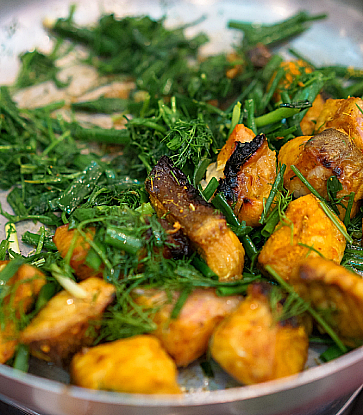At 14, Boutin realised he preferred the hands-on experience of working in a kitchen over rigorous academics in a classroom, and became a chef. He has since worked at three-Michelin-starred restaurants such as Lameloise and Troisgros, as well as travelled the world working in restaurants of top hotels.
In 2013, Boutin finally settled down in Hong Kong to open Épure, a French restaurant that emphasises the origins of ingredients, respects the French seasons and the terroir, complemented by Boutin's concise and refined cooking method. It was awarded a Michelin star in 2017.
We speak to Boutin to find out more.
I have been working in the industry for 31 years, starting with classic cuisine. With some luck, I got the chance to work at some great iconic restaurants and learnt the fundamentals from there. I also travelled around Europe and worked overseas for some great luxury hotel brands, in countries including the Caribbean, Boston, Maldives, French Polynesia and Hong Kong.
How would you describe your culinary style?
Pure, simple flavours with timeless ingredients that are light, seasonal and healthy as much as possible. The key is respecting the ingredients, and cooking them with the right seasoning and consistency.
Where do your inspirations come from?
I started cooking with my memories of food. Now I am inspired by my experiences from working in restaurants around the world, combined with the research of the history and origin of the ingredients and recipes.

I was looking to come back to Asia and if possible Hong Kong since I had my first experience few years ago when I had the opportunity to open the Landmark Mandarin Oriental as executive sous chef.
I like the environment — an opportunity to move fast with a knowledgeable and hardworking team and being able to get the best ingredients from all over the world.
What is the soul of French cuisine?
The soul is the soil of French ground, the climate and environment called ‘terroir’ and the unique and rich culture and history that has been built for few centuries.
What are the ingredients most essential to French cuisine?
If I mentioned just the basics, it would be salt, pepper — including the Espelette chili for seasoning, lemon and vinegar for that refreshing kick, garlic, shallots and herbs for the aroma, and sauces (including stock) just to enhance the flavour and texture to balance the dish

Torched duck foie gras with pear and caramel jus, the button mushroom soup with baby spinach gnocchi, and the revisited Vol au Vent with seafood and licorice sauce. These signatures dishes were created for Épure based on the must-have dishes in French cuisine and some recipes I have been cooking during my time in some of the restaurants I worked.
Can you tell us how do you make these dishes?
The duck foie is poached and torched, served with a poached pear and hazelnut shavings, and a slow-cooked sauce made with duck jus, honey, vinegar and spices. The mushroom soup is made with a large quantity of white button mushrooms reduced to keep only the essence, some cream and served with homemade baby spinach gnocchi.
The vol au vent uses only line-caught fish and lobster or langoustine. The seafood is seared, we add seasonal vegetables, and make a light fluffy puff pastry ring and a coulis from langoustine stock.

Be curious, stay focused and do not be afraid to ask questions and make mistakes. It is part of building up yourself and your experience, then everything else will come together.
Recommended reading: View more chef stories here.











_THUMB_363_X_484.JPG)





